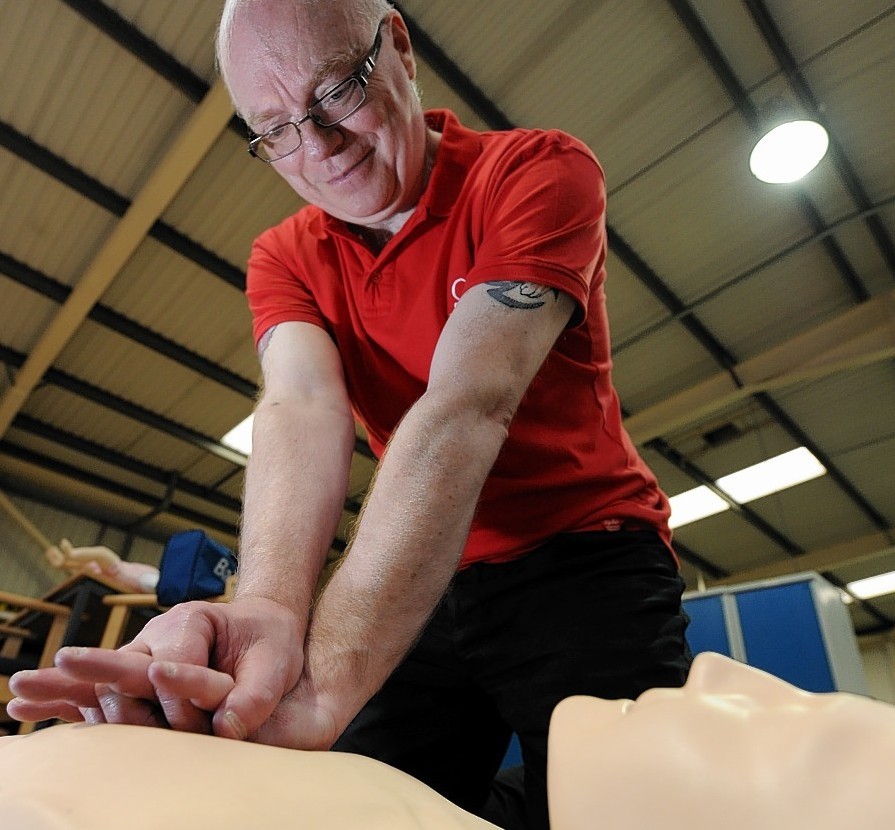What would you do if someone collapsed in front of you? Would you take action like bus driver Shane Mitchell did when passenger Allan Mclean suffered a heart attack onboard his vehicle in February?
Mr Mclean, 72, was on board a First Bus service when he collapsed. Passengers alerted Mr Mitchell, who performed lifesaving CPR on the retired Aberdeen City Council labourer.
Last month Mr Mclean was reunited with Mr Mitchell, who had received first-aid training while he was working for the Scottish Ambulance Service, so he could thank the driver who saved his life.
Jim Aitken, a paramedic with SAS and the regional co-ordinator for the British Heart Foundation’s Heartstart Grampian campaign, said the episode was evidence of how vital public CPR is to saving people’s lives.
The 51-year-old said: “The role that the public play after someone has suffered a cardiac arrest can not be underestimated. Unless CPR is started pretty much immediately after someone’s heart stops, the chances of that person surviving decrease rapidly.
“Every minute that CPR delayed, the chance of survival decreases by 10%. So if CPR is delayed for even two or three minutes, that person’s chance of survival reduces by 20 to 30%.”
To help those who might need to help out in these kinds of situations, the British Heart Foundation (BHF) offers courses to arm members of the public with life-saving skills.
The Heartstart campaign was started almost 20 years ago and offers free courses to individuals, groups and businesses.
The two-hour courses teach people five different life-saving actions:
treating unconscious casualties;
recognising heart attacks;
CPR;
dealing with choking;
how to deal with severe bleeding.
Jim said: “Recognition of a heart attack is something I think is vital. If you can recognise it’s happening in the early stage and get appropriate help, that in itself is a major life saver.
“If things do escalate and the person’s heart stops beating, getting early CPR started and getting early access to a defibrillator, is vital in attempting to restart that person’s heart again.”
Jim said one of the main things that stop people from springing into action is a “fear factor”.
“One of the big things that we do get are people saying they are afraid of doing things wrong and they are afraid of hurting the casualty and making things worse. But realistically if someone’s heart has stopped, you can’t make it worse, you can only make things better.
“There is a lot of fear and anxiety with members of the public but once you’ve completed the course, the vast majority of people are much happier and have more of an understanding and why it needs to be done and the benefits that can potentially come from it.”
He explained that the course is open to everyone – a reassurance for those who think they might not be competent to complete it and get to grips with skills that will save someone’s life.
From seven-year-olds to pensioners, Jim said they have had a wide range of age groups take part in the class. He explained they once had a woman who was confined to a wheelchair who could not physically do the CPR complete the session.
He said: “But she came along to the course, she learned the skills and at the end of it, she was able to tell someone else what to do.
“We said to her ‘this patient has collapsed, what should you do?’ And she just got one of the lads and talked him through it, which was perfect. You don’t even have to be physically capable of doing the CPR to benefit from the course. It is open to anybody.”
Two years ago the BHF ran a high-profile campaign featuring Vinnie Jones which raised awareness of the hands-only CPR technique and featured the song “Staying Alive” by the Bee Gees.
Jim believes that even a TV advert can help arm people with skills to save someone’s life.
He said: “The campaign has been shown to save lives for people who have never done a course; they saw the advert, witnessed someone collapsing and remembered what was said in the advert.
“There was a report just when the campaign had launched about a chap who had collapsed on the golf course and his mates had seen the advert the night before and just did exactly what they saw in the advert and he lived to tell the tale.
“People are definitely more aware of what to do now but still there is a little bit of fear and lack of confidence,
“The Heartstart course gives people an extra bit of knowledge and confidence to know they are doing the right thing.
“It’s a simple enough course, there’s nothing technical about it, it’s very easy to understand, nothing complicated, nothing there to catch people out.
“I would highly encourage anyone to learn these skills because while it’s not something you want to be doing, you’re never sure when it might be required. It could be a complete stranger in the street or a member of your own family or a friend that collapses.”
For more information, visit www.BHF.org. uk or e-mail james.aitken@nhs.net to learn more about courses in your area.
